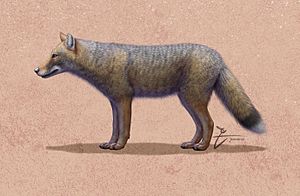Dusicyon avus facts for kids
Quick facts for kids Dusicyon avus |
|
|---|---|
 |
|
| Artistic reconstruction | |
| Conservation status | |
| Scientific classification | |
| Genus: |
Dusicyon
|
| Species: |
avus
|
| Synonyms | |
|
|
The Dusicyon avus was an extinct wild dog, a type of canid, that lived in South America. It was part of the Dusicyon family, which also included the Falkland Islands wolf. This animal was quite large, similar in size to a German shepherd dog.
Scientists believe the D. avus lived during the Pleistocene and Holocene periods. It was a close relative of the Falkland Islands wolf (Dusicyon australis). The Falkland Islands wolf actually came from a group of D. avus that moved to the islands. This ancient dog might have lived until about 400 years ago.
Contents
Where Did the Dusicyon avus Live?
The Dusicyon avus lived across a large area in South America. Its home stretched through the Pampas grasslands and Patagonia in the southern parts of the continent. Scientists estimate its territory was about 762,351 square kilometers.
Fossils of D. avus have been discovered in several countries. These include Argentina, Brazil, Chile, and Uruguay. Important fossil sites are the Luján Formation in Argentina and the Milodón Cave in Chile.
What Did the Dusicyon avus Eat?
The Dusicyon avus was mostly a meat-eater. Its diet was more focused on meat than that of modern foxes. It probably hunted small mammals. It also likely ate parts of larger animals that had already died.
This is different from the Falkland Islands wolf, which mainly ate seabirds and seal pups. The D. avus looked similar to jackals. This suggests it might have lived and hunted in a similar way to them.
How Did Dusicyon avus Interact with Humans?
There is evidence that Dusicyon avus might have had a special connection with ancient humans. In Argentina, a young D. avus was found buried in a human grave. This grave dates back to around 2,500 BCE.
The way it was buried was similar to how humans were buried nearby. This suggests that the animal might have been a pet. It could have been considered part of the human family or social group.
Why Did the Dusicyon avus Disappear?
The Dusicyon avus became extinct a long time ago. Early ideas suggested it died out around 1000 BCE. More recent studies show it might have survived much longer.
When Did Dusicyon avus Go Extinct?
New research suggests the last D. avus in the Pampean Region was seen around 700 years ago (1232–1397 AD). In southern Patagonia, it might have survived until about 400 years ago (1454–1626 AD).
Some historical accounts hint that it might have lived even later. Charles Darwin, in his book The Voyage of the Beagle, mentioned that people in South America didn't know about the Falkland Islands wolf. This made him think it wasn't alive on the mainland then.
However, there are stories from indigenous people. Around 1900, the Ona of Tierra del Fuego spoke of two types of foxes. One of these was said to be unusually large. If this "big fox" was the D. avus, it means it could have survived into the 20th century in that area.
What Caused the Extinction of Dusicyon avus?
The reason for the extinction of D. avus is still a bit of a mystery. It was a generalist animal, meaning it could adapt to different environments and foods. It's not clear why it died out, especially so long after the big Quaternary extinction event.
Scientists don't have strong proof that climate change caused its extinction. There's also no clear sign that it mixed with domestic dogs. Its skull shape and DNA stayed the same over thousands of years.
Ancient people used Dusicyon for special ceremonies. Its remains, often teeth, are found in many old human sites. This shows it was important to them. The D. avus had low genetic diversity, even across its wide range. This might mean its population was small or went through a bottleneck. It's likely that a mix of climate changes and human activities led to its disappearance.
See also
 In Spanish: Dusicyon avus para niños
In Spanish: Dusicyon avus para niños


